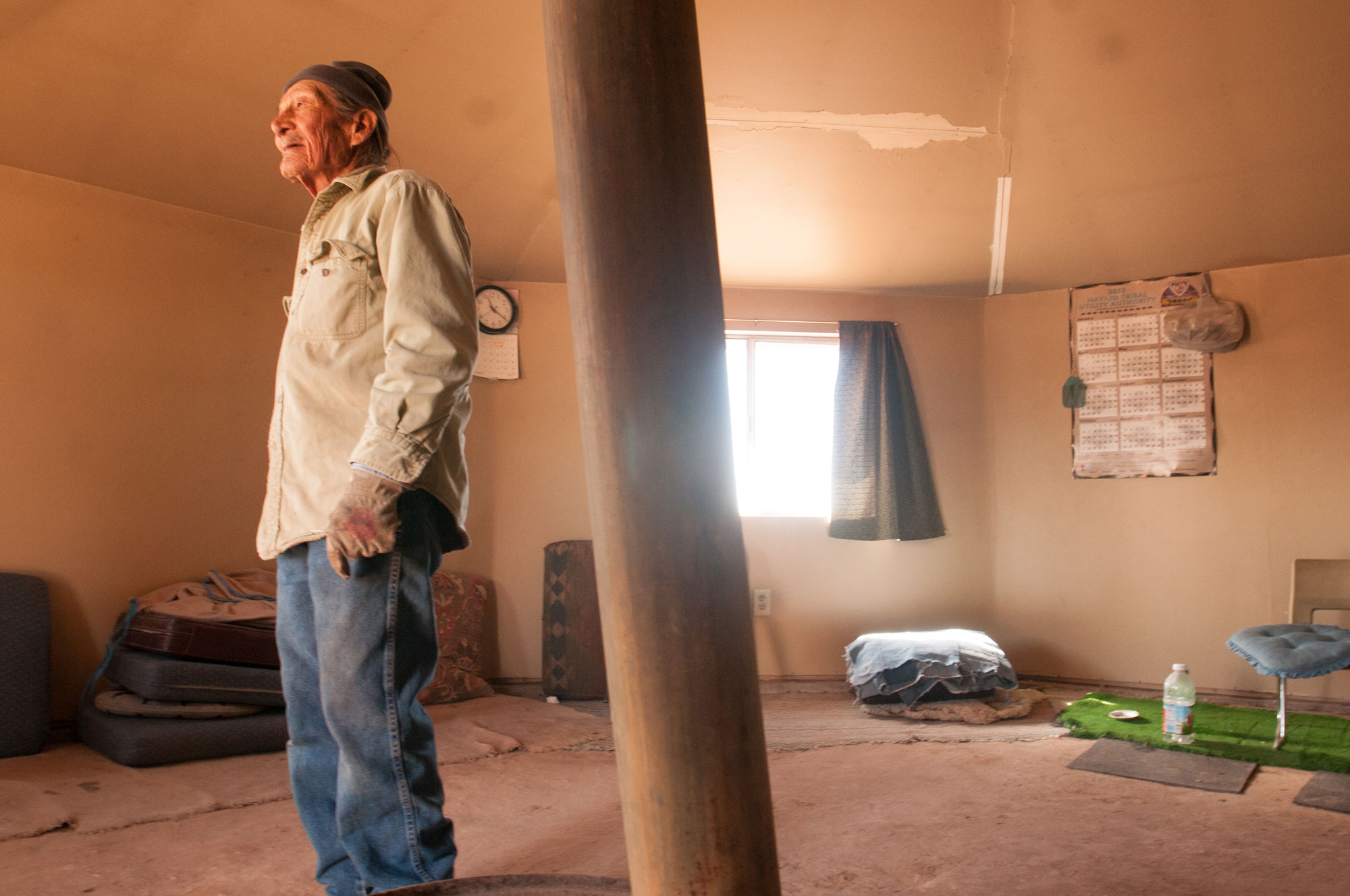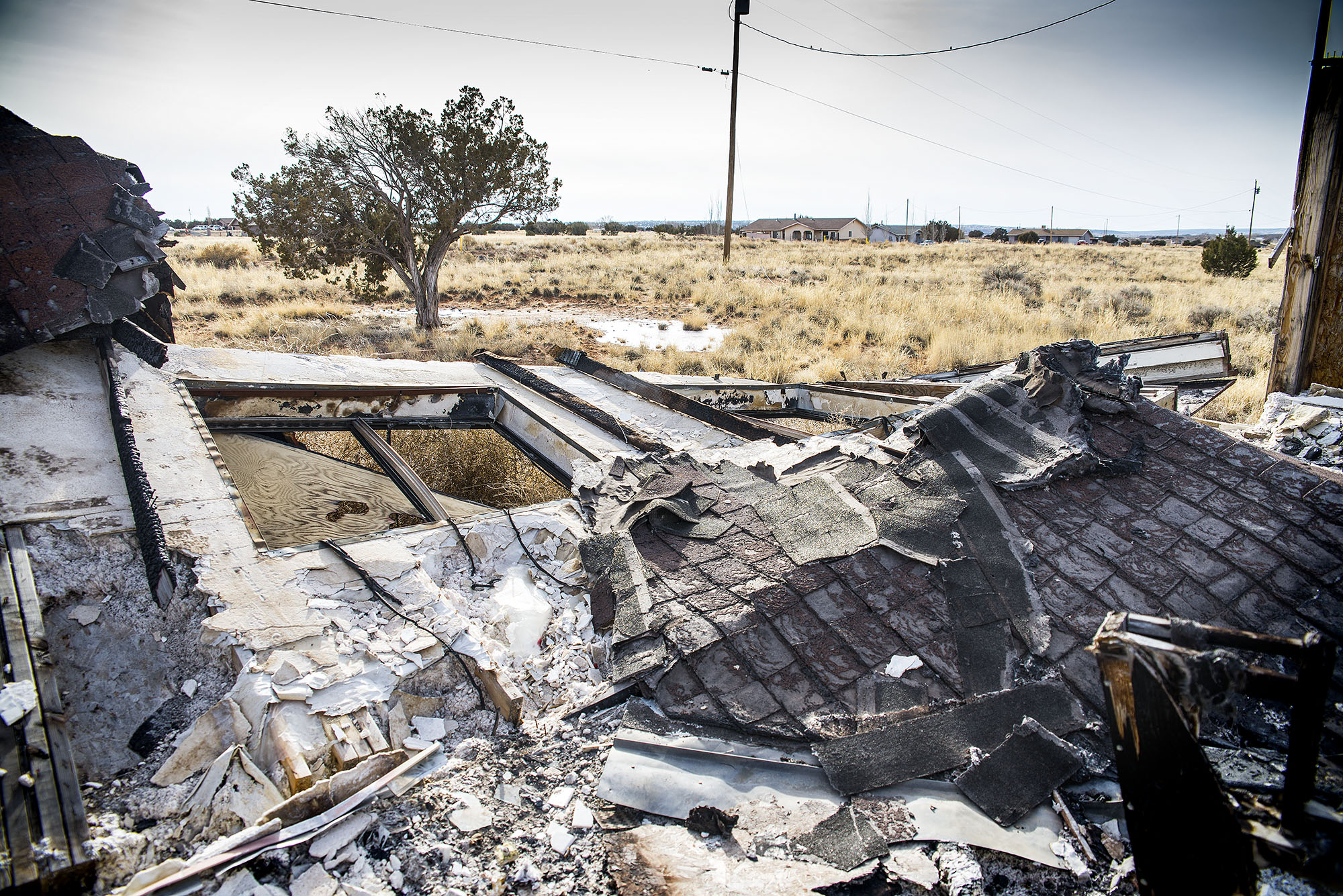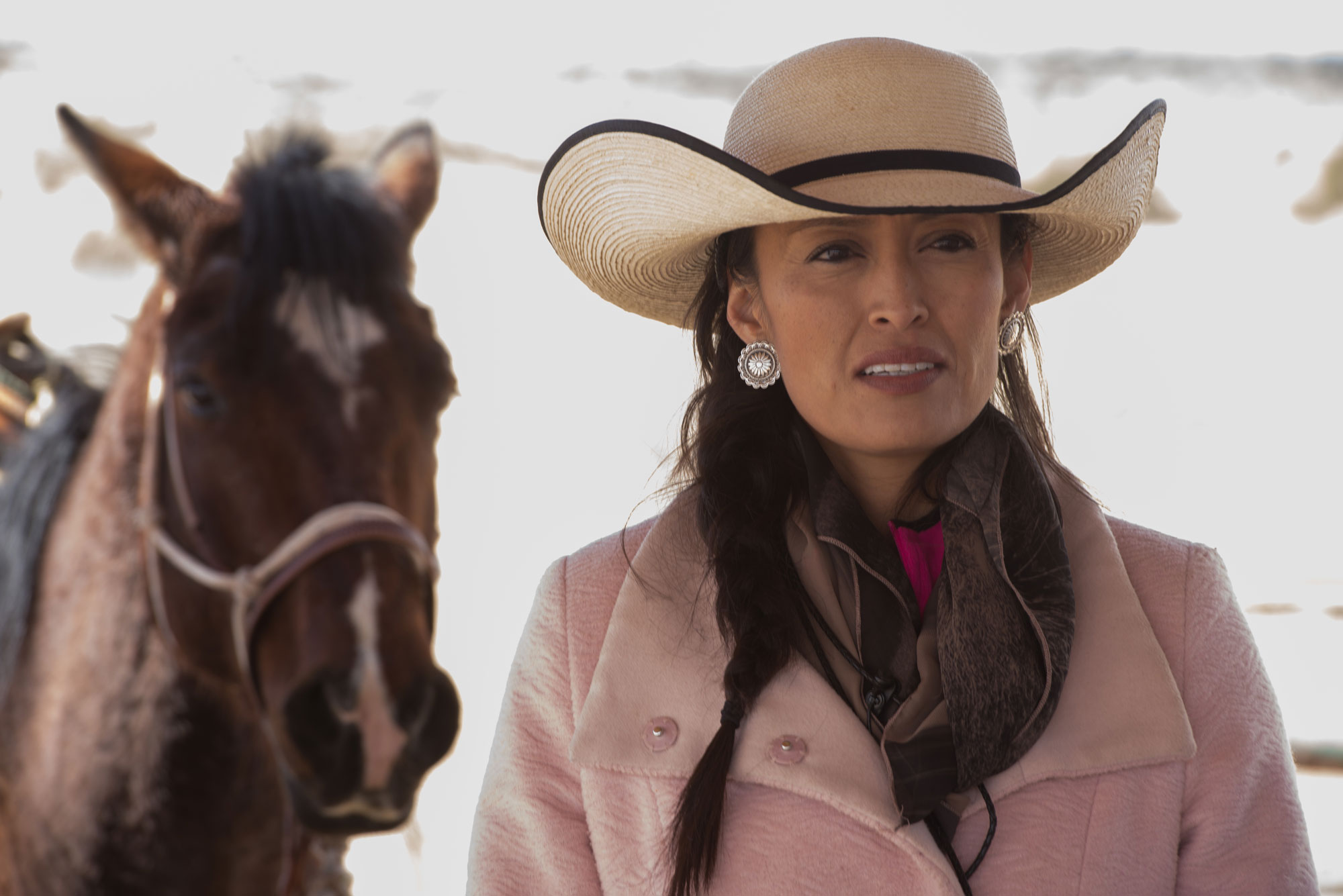
Cracking Homes
Thomas Bedonie stands in his ceremonial hogan in the community of East Mill. Soil shifting has caused cracks to develop all over his hogan and his house. – Photo by Josh Biggs

loading
Mae Horseman is a former Navajo Nation judge and now serves on the local government of the Nahata Dziil Chapter in the New Lands. She says relocation was hardest on elderly Navajos like her mother because most had never lived in another place. – Photo by Amanda Ray
In 1974, Congress settled a 16-year lawsuit between the Navajo and Hopi nations over which tribe owned nearly 1.8 million acres of land long shared by both groups.
The federal government apportioned the contested land and ordered members of each tribe to leave what was now considered the other tribe’s land. The vast majority of those relocated were Navajos deemed to be living on Hopi land.
What resulted was one of the largest and most expensive relocation projects in U.S. history. Over the past four decades, the government has spent at least $575 million relocating more than 3,500 Navajo families.
The largest concentration of relocatees — about 400 families — moved to an area in northeastern Arizona they called the New Lands.
Government officials promised that Navajos moving to the New Lands would have modern houses along with jobs, a hospital, a grocery store and plenty of land to graze sheep and cattle.
But residents of the New Lands say the reality has been quite different.
The U.S. Army establishes Ft. Defiance in Arizona to combat Native American tribes, including the Navajos.
Navajos are released from a prison camp in New Mexico after signing a peace treaty with the United States. The government creates a reservation for Navajos along the New Mexico-Arizona border. But as the Navajo population grows, Hopis complain of Navajo encroachment onto their land.
President Chester Arthur designates 2.5 million acres in northern Arizona for the Hopi Tribe and “such other Indians as the Secretary of the Interior may see fit to settle thereon.” This area becomes known as the 1882 Executive Order Area, which is shared by Hopis and Navajos.
Nina Yazzie first relocated to the New Lands community of East Mill in the late 1980s. But soil problems beneath her home caused it to become structurally unsound. The government built another house for her in the nearby community of Antelope Wells where she raises cattle. – Photo by Josh Biggs
The U.S. government expands the Navajo reservation border to include land that the Hopis claim is rightfully theirs. Hopis are only given exclusive use to part of the 1882 Executive Order Area known as District 6.
Hopis file a lawsuit to determine which tribe has legal rights to the 1882 Executive Order Area.
A federal court rules that Hopis and Navajos have “joint, undivided and equal rights” to the Executive Order Area, except for the area known as District 6.
A federal court orders Navajos to drastically reduce the number of livestock kept on the Joint Use Area. A construction freeze is imposed that prevents Navajos from improving their homes or property in any way without approval of the Hopi Tribe.
Congress passes the Navajo-Hopi Land Settlement Act to “provide for final settlement” of the land conflict by partitioning the disputed area. People living on the wrong side of the new border are told they will have to move.
The federal government buys 352,000 acres of private ranch land near Sanders, Ariz., to create communities for relocatees. This area becomes known as the New Lands.
Nahata Dziil Chapter is formed in the New Lands. Families begin moving from the disputed area to their new homes.
Click the map markers below for more information
Some Navajos embraced the idea of moving away from the reservation, to new homes with modern conveniences such as electricity and running water.
But for most people, the prospect of moving meant a loss of economic stability, spiritual connection and familial support.
June Benally testified before Congress and told them she could not imagine living anywhere except for the home where she was born in the early 1920s, just north of Second Mesa, Arizona.
Her parents buried her umbilical cord in the sheep coral on this land, an act that symbolically ties Navajos to their birthplace forever. Her children were born here, and she buried their umbilical cords deep in the earth.
Even though she made little money, she also had no bills. She grazed sheep for food and used the wool to make rugs that she sold at the trading post. She hauled water and cut wood for heat.
June’s daughter, Mae Horseman, said leaving home nearly killed her mother. “She said she almost died for want to return to this place.”
Betty Manybeads says she would not have moved to the New Lands if she had known alcohol would be sold here. She says drug and alcohol abuse has devastated the community. – Photo by Amanda Ray
In the 1980s, families reluctantly began moving to the New Lands. Parents told themselves that their children would benefit from living in this new place, because they had been promised jobs. But economic development never arrived. A planned factory did not open. A grocery store burned to the ground and was replaced by a liquor store. The nearest grocery store is a 100-mile roundtrip drive. Residents say they live in fear because of the lack of police protection. When people call for help, police officers respond hours later, if at all.
Throughout the Navajo New Lands, burned-up houses litter the high-desert landscape because people cannot call the fire department, which is located as far as 30 miles away from some homes. Neighborhoods were built without telephone lines, and many cell phones don’t work in the outlying areas.
Houses constructed just 25 years ago are cracking along the floors, along the ceilings and around the windows. A few people’s homes have separated so badly that the federal Office of Navajo and Hopi Indian Relocation built them new houses. But most people just wait and wonder if their houses will be standing in another decade.

Thomas Bedonie stands in his ceremonial hogan in the community of East Mill. Soil shifting has caused cracks to develop all over his hogan and his house. – Photo by Josh Biggs

Fire protection is virtually non-existent in the New Lands. The fire department is located as far as 30 miles away from some communities, and neighborhoods don’t have fire hydrants for additional water. – Photo by Amanda Ray

Ted Nez gathers chopped wood elders of the Nahata Dziil Chapter in the New Lands. Many people burn wood in order to keep down utility bills. – Photo by Amanda Ray
Alcohol and drugs became a poisonous salve for some relocatees who were overwhelmed by the stress of moving, paying bills and joblessness. Residents say the preponderance of liquor stores in the area -- and the lack of other businesses -- has been a curse on the New Lands.
Elders tell stories of their own adult children beating them, of being afraid to leave their houses for fear of being robbed, of being raped. They recount stories of friends being beaten, dumped and left for dead. They tell of relatives who’ve frozen to death while passed out drunk in a culvert under the highway and scores of loved ones taken by drunk drivers.
In January 2014, tension over alcohol and drugs in the New Lands came to a head. Gary McDonald, the owner of three area liquor stores was arrested for the second time on drug and weapons charges. Even though they feared retribution, a group of senior citizens has mobilized a campaign to close the liquor stores and take back their community.
In Sanders, Ariz., men and women gather all day, every day, to drink alcohol behind a boarded-up food stand in the center of town. There are four liquor stores in the New Lands but no grocery stores. – Photo by Josh Biggs
Glendora Burnside has been tending the window at the Ole Red Barn liquor store for a decade. There are few jobs in this remote area 45 miles west of Gallup along Interstate 40. Like the other women who work here, Burnside is a single mom. So she figures this job is better than no job. – Photo by Amanda Ray
Marjorie Brown stopped drinking 17 years ago. She says she is praying that her relatives will stop abusing alcohol too. – Photo by Amanda Ray
Frank Nelson is a rancher from East Mill, Ariz., in the New Lands. After he relocated from Big Mountain, Ariz., Nelson found it easy to buy alcohol and became an alcoholic. These days, Nelson spends his time ranching instead of drinking. – Photo by Josh Biggs
Padres Mesa cowboy Anderson White grew up in the New Lands. He earns a living from ranching and hopes to pass on the tradition of raising livestock to his 2-year-old son. – Photo by Josh Biggs
The New Lands settlements are located within 352,000 acres of ranchland carpeted with tall grass, sagebrush and squatty conifers. The 14 range communities were intended to be similar to the living arrangements that Navajo families left behind in the disputed land.
Houses were built so that extended families could live next to one another; shared grazing areas were established so that people could keep sheep and cattle.
But residents complain that the federal Office of Navajo and Hopi Indian Relocation limits the number of livestock each family can keep. Because land use is highly regulated, people often find themselves being fined by the same federal office that relocated them, deepening resentment toward the federal government.
Keeping livestock is central to Navajo identity. But Navajos’ connection to the land and to animals is not just spiritual; it is also financial. People depend on income from selling cattle as well as rugs made from the wool of their Churro sheep.
In 2009, the federal relocation office established a demonstration ranch in the New Lands to help families increase their income from selling cattle.
Padres Mesa cowboys teach locals the best practices in agriculture, including breed selection for highest market value, low stress animal handling and sustainable range management.
The result is Navajo Beef, a grass-fed, premium Grade A brand that is purchased by Navajo-owned casinos and generates twice the income for New Lands ranchers as other livestock.
“We are turning this big ‘ole negative of relocation into a positive,” says New Lands rancher Kim Yazzie. “We now have this awesome product, this Native American beef product.”

Padres Mesa Ranch is helping Navajos to earn a living from ranching and pass the agricultural lifestyle on to their children. – Photo by Josh Biggs

Padres Mesa cowboys and New Lands ranchers crack jokes and tease one another before a cattle drive. Ranching is a common bond throughout the community. – Photo by Amanda Ray

Kim Yazzie moved to the New Lands when she was a child. She learned about the importance of livestock from her grandparents, and later became an agriculture teacher. She now works for a national food company distributing Navajo Beef. – Photo by Josh Biggs